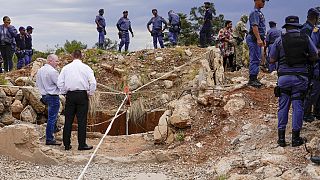Nigeria
As the world's demand for chocolate grows, cocoa farmers in Nigeria are moving into protected areas of a forest reserve that is home to endangered species like African forest elephants.
Over the course of two visits and several days, The Associated Press repeatedly documented farmers harvesting cocoa beans where that work is banned in conservation areas of Omo Forest Reserve, a protected tropical rainforest 135 kilometers (84 miles) northeast of the coastal city of Lagos in southwestern Nigeria.
Cocoa from the conservation zone is purchased by some of the world’s largest cocoa traders, according to company and trade documents and AP interviews with more than 20 farmers, five licensed buying agents and two brokers all operating within the reserve.
The traders supply Nigerian cocoa to some of the world's largest chocolate manufacturers including Mars Inc. and Ferrero, but because the chocolate supply chain is so complex and opaque, it’s not clear if cocoa from deforested parts of Omo Forest Reserve makes it into the sweets that they make, such as Snickers, M&Ms, Butterfinger and Nutella.
Mars and Ferrero list farming sources on their websites that are close to or overlap with the forest but do not provide specific locations.
Kaseem Olaniyi acknowledges he farms illegally in the conservation zone after moving there in 2014 from a neighbouring state.
He says, “We know that where we are (farming) is a reserved area, but when we are done, everyone will go back to their villages to start up a business.”
For him illegal cocoa farming is essential “I chose cocoa farming because I needed to survive and, “it was what my father did for a living”.
Farmers say they move into protected areas of the reserve because their cocoa trees in other parts of the West African country are aging and not producing as much.
Conservationists also point to the world’s increasing demand for chocolate.
Emmanuel Olabode, Project Manager from the Nigeria Conservative Foundation, Omo Forest says.
“The project work here is very important. It is crucial to conservation because for the fact that this is one of the remaining viable habitats that we can have, where we have forest elephants. And if we are not careful and the entire area is degraded, then we won’t have elephants again. So, it is very important for conservation”.
The government in Ogun state, which owns the forest, said in a statement to AP that the “menace of cocoa farming” in the reserve dates back decades and that “all the illegal farmers were forcefully evicted” in 2007 before they found their way back.
The farmers have been ordered not to start new farms, and those who spoke with AP said they are complying.
But forest guards said new farms are sprouting up in remote areas that are difficult to detect.
They told AP that previous arrests have done little to stop the farmers from returning and that has led to a sense of futility when they encounter illegal farming.
The rangers — who work for the government’s conservation partner, the nonprofit Nigerian Conservation Foundation — and forest guards who are employed by the state government both told AP that lax government enforcement has made combating cocoa expansion a challenge.
"What makes the project work difficult is the fact that we are faced with a number of threats while carrying out our activities. You know, we are faced with threats from logging activities, threats from poaching, and expansion of farming and community settlements. So that's really… they're big issues here because it's undermining conservation efforts" explains Olabode.
The conservation zone, which spans about 650 square kilometers (250 square miles), is the only remaining vital rainforest in Nigeria’s southwest, conservation officials say.
Such forests help absorb carbon from the atmosphere and are crucial for Nigeria to meet its pledges under the Paris climate agreement.
Besides helping fight climate change, the forest is designated an Important Bird and Biodiversity Area by BirdLife International, with significant populations of at least 75 bird species.
The European Union, the largest destination of cocoa from West Africa, enacted a new regulation on deforestation-free products in June that requires companies selling commodities like cocoa to prove that they have not caused deforestation.
Big companies must ensure they’re following the rules by the end of 2024.
Experts at the Cocoa Research Institute of Nigeria are launching a “Trace Project” in six southern states — though it doesn’t include Ogun state where Omo Forest Reserve is located — to advance efforts against deforestation in cocoa production and ensure Nigeria’s cocoa is not rejected in Europe.
Dr. Babajide Agboola, an independent environmental ecologist, says forest loss has significant impacts on the rivers whose source is in the Omo forest, degrading water quality and leading to soil erosion.
" We are putting money over morals. So, unless we reverse this trend the consequences that we end up with will be dire."
Nigeria is the world’s fourth-largest producer of cocoa, accounting for more than 5% of global supply, according to the International Cocoa Organization.
It’s far behind the world’s largest producers, Ivory Coast and Ghana, which together supply around half of the world’s demand and are often singled out in companies’ sustainability programme.
According to World Bank trade data and Nigeria's export council, more than 60% of Nigeria’s cocoa heads to Europe and about 8% to the United States and Canada.












Go to video
Ghana overtakes Nigeria in U.S. visa overstay rates, new report reveals
01:00
Chidimma Adetshina crowned Miss Universe Africa and Oceania
01:05
Nigeria: Tinubu orders release of child protestors
01:11
Paris' Salon du Chocolat opens its doors
Go to video
Nigerian MP caught on camera assaulting delivery driver
01:00
Pics of the day: October 29, 2024